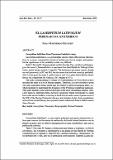Please use this identifier to cite or link to this item:
http://hdl.handle.net/10261/59792Share/Export:
 SHARE
BASE SHARE
BASE
|
|
| Visualizar otros formatos: MARC | Dublin Core | RDF | ORE | MODS | METS | DIDL | DATACITE | |

| Title: | El "Laserpitium latifolium" pirenaico-cantábrico |
Authors: | Montserrat, Pedro | Keywords: | Laserpitium Taxonomy Biogeography Iberian Peninsula Taxonomía Biogeografía Península Ibérica |
Issue Date: | 2003 | Publisher: | Universidad de Barcelona | Citation: | Acta Botanica Barcinonensia 49: 19-38 (2003) | Abstract: | [EN] Laserpitium latifolium L. is a polymorphic species which offers precise information on ecotone communities between herbaceous forest margin and pasture,
but the significance of its variability results very difficult.
Both C. Pau and Fr. Sennen pointed out this diversity. Pau, «in litteris ad Sennen»,
gave the name L. flammulifolia to a specimen from Sant Hipòlit de Voltregà (Catalonia), which Sennen named L. hippoliti. The herbarium specimens remain, though
not well preserved, in BC and MA, but the names had not been correctly published.
Also Lacaita gave the name L. gallecicum (n. nud.) to a plant which Merino identified as var. longifolium (Fl. Galicia I: 567, Merino nº 671).
The tasks corresponding to volume 10 (Umbelliferae) of Flora Iberica have
included the study of a lot of Iberian samples. Therefore, it is now possible to point
out some noticeable forms which may be related to phytosociological units, i.e.,
which facilitate to understand the dynamics of the Pyrenean-Cantabrian landscape.
This paper includes some selected drawings of the most outstanding samples. Also,
a new taxon (L. latifolium subsp. merinoi) is proposed, which corresponds to a small
form with narrow leaflets, occurring in birch forests and in some riparian areas of
the NW of the Iberian Peninsula (Ancares and Asturias-León). Some populations
arrived from central Europe have persisted (and evolutioned) both in Galicia and in
Sierra Nevada. [ES] Laserpitium latifolium L. es una especie polimorfa que aporta información valiosa para conocer las fitocesosis de sustitución, del borde forestal herbáceo con las plantas de prado, pero es difícil la interpretación de tanta variabilidad y más aun su publicación correcta. Tanto C. Pau como Fr. Sennen ya destacaron unas formas, y el primero, «in litteris ad Sennen», dio el nombre L. flammulifolia a una planta de San Hipòlit de Voltregà considerada por el segundo L. hippoliti Sen.; quedan testimonios –deteriorados– en los herbarios BC y MA, pero no se publicaron correctamente. También Lacaita llamó L. gallecicum (n. nud.) a una planta (L. galloecicum Pau, n. nudum) que Merino denominó var. longifolium (Fl. Galicia I: 567, Merino nº 671). Los trabajos para el volumen 10 (Umbelíferas) de Flora Iberica facilitaron el estudio de mucho material peninsular, y ahora podemos destacar unas formas notables con interpretación fitosociológica, es decir, aptas para conocer la dinámica del paisaje pirenaico-cantábrico. Aportamos dibujos de los ejemplares destacados y proponemos un taxón nuevo (L. latifolium subsp. merinoi), para una forma raquítica de segmentos foliares estrechos, que aparece en abedulares y en algunas riberas del NW peninsular (Ancares y Asturias-León). Del área europea llegaron a España, donde persisten y evolucionan, pequeñas poblaciones con formas notables por sus caracteres detectables, tanto en Galicia como Sierra Nevada. |
Description: | 19 páginas, 8 figuras. | Publisher version (URL): | http://www.raco.cat/index.php/ActaBotanica/article/view/59834/99288 | URI: | http://hdl.handle.net/10261/59792 | ISSN: | 0210-7597 |
| Appears in Collections: | (IPE) Artículos |
Files in This Item:
| File | Description | Size | Format | |
|---|---|---|---|---|
| 2003_Montserrat_LASERPITIUM.pdf | 4,44 MB | Adobe PDF |  View/Open |
CORE Recommender
Page view(s)
263
checked on Apr 23, 2024
Download(s)
158
checked on Apr 23, 2024
Google ScholarTM
Check
WARNING: Items in Digital.CSIC are protected by copyright, with all rights reserved, unless otherwise indicated.
